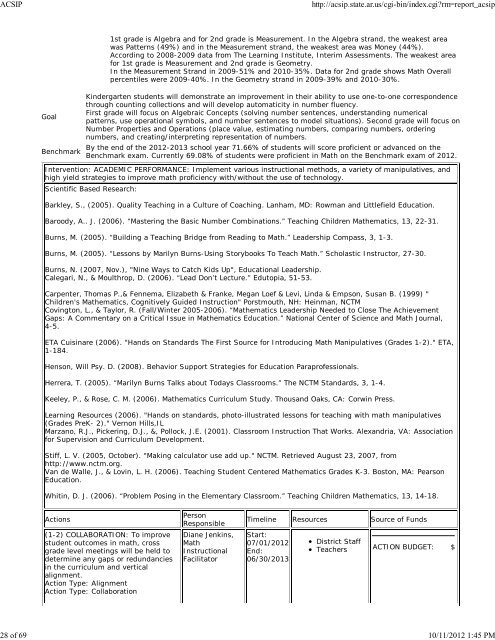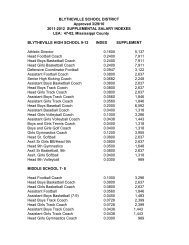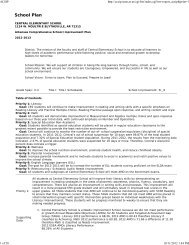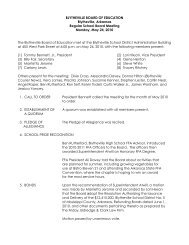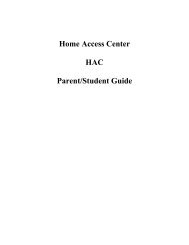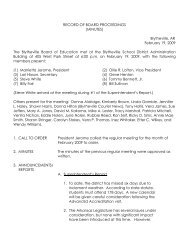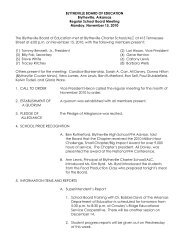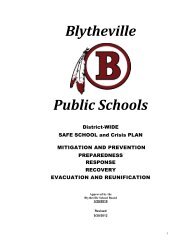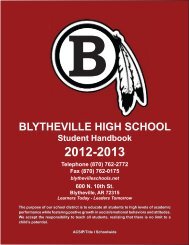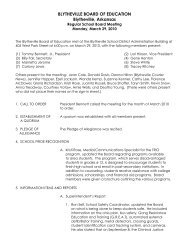School Plan - Blytheville Public Schools
School Plan - Blytheville Public Schools
School Plan - Blytheville Public Schools
You also want an ePaper? Increase the reach of your titles
YUMPU automatically turns print PDFs into web optimized ePapers that Google loves.
ACSIP http://acsip.state.ar.us/cgi-bin/index.cgi?rm=report_acsip<br />
Goal<br />
Benchmark<br />
1st grade is Algebra and for 2nd grade is Measurement. In the Algebra strand, the weakest area<br />
was Patterns (49%) and in the Measurement strand, the weakest area was Money (44%).<br />
According to 2008-2009 data from The Learning Institute, Interim Assessments. The weakest area<br />
for 1st grade is Measurement and 2nd grade is Geometry.<br />
In the Measurement Strand in 2009-51% and 2010-35%. Data for 2nd grade shows Math Overall<br />
percentiles were 2009-40%. In the Geometry strand in 2009-39% and 2010-30%.<br />
Kindergarten students will demonstrate an improvement in their ability to use one-to-one correspondence<br />
through counting collections and will develop automaticity in number fluency.<br />
First grade will focus on Algebraic Concepts (solving number sentences, understanding numerical<br />
patterns, use operational symbols, and number sentences to model situations). Second grade will focus on<br />
Number Properties and Operations (place value, estimating numbers, comparing numbers, ordering<br />
numbers, and creating/interpreting representation of numbers.<br />
By the end of the 2012-2013 school year 71.66% of students will score proficient or advanced on the<br />
Benchmark exam. Currently 69.08% of students were proficient in Math on the Benchmark exam of 2012.<br />
Intervention: ACADEMIC PERFORMANCE: Implement various instructional methods, a variety of manipulatives, and<br />
high yield strategies to improve math proficiency with/without the use of technology.<br />
Scientific Based Research:<br />
Barkley, S., (2005). Quality Teaching in a Culture of Coaching. Lanham, MD: Rowman and Littlefield Education.<br />
Baroody, A.. J. (2006). “Mastering the Basic Number Combinations.” Teaching Children Mathematics, 13, 22-31.<br />
Burns, M. (2005). “Building a Teaching Bridge from Reading to Math.” Leadership Compass, 3, 1-3.<br />
Burns, M. (2005). “Lessons by Marilyn Burns-Using Storybooks To Teach Math.” Scholastic Instructor, 27-30.<br />
Burns, N. (2007, Nov.), "Nine Ways to Catch Kids Up", Educational Leadership.<br />
Calegari, N., & Moulthrop, D. (2006). “Lead Don’t Lecture.” Edutopia, 51-53.<br />
Carpenter, Thomas P.,& Fennema, Elizabeth & Franke, Megan Loef & Levi, Linda & Empson, Susan B. (1999) "<br />
Children's Mathematics, Cognitively Guided Instruction" Porstmouth, NH: Heinman, NCTM<br />
Covington, L., & Taylor, R. (Fall/Winter 2005-2006). “Mathematics Leadership Needed to Close The Achievement<br />
Gaps: A Commentary on a Critical Issue in Mathematics Education.” National Center of Science and Math Journal,<br />
4-5.<br />
ETA Cuisinare (2006). "Hands on Standards The First Source for Introducing Math Manipulatives (Grades 1-2)." ETA,<br />
1-184.<br />
Henson, Will Psy. D. (2008). Behavior Support Strategies for Education Paraprofessionals.<br />
Herrera, T. (2005). “Marilyn Burns Talks about Todays Classrooms.” The NCTM Standards, 3, 1-4.<br />
Keeley, P., & Rose, C. M. (2006). Mathematics Curriculum Study. Thousand Oaks, CA: Corwin Press.<br />
Learning Resources (2006). "Hands on standards, photo-illustrated lessons for teaching with math manipulatives<br />
(Grades PreK- 2)." Vernon Hills,IL<br />
Marzano, R.J., Pickering, D.J., &, Pollock, J.E. (2001). Classroom Instruction That Works. Alexandria, VA: Association<br />
for Supervision and Curriculum Development.<br />
Stiff, L. V. (2005, October). "Making calculator use add up." NCTM. Retrieved August 23, 2007, from<br />
http://www.nctm.org.<br />
Van de Walle, J., & Lovin, L. H. (2006). Teaching Student Centered Mathematics Grades K-3. Boston, MA: Pearson<br />
Education.<br />
Whitin, D. J. (2006). “Problem Posing in the Elementary Classroom.” Teaching Children Mathematics, 13, 14-18.<br />
Actions<br />
(1-2) COLLABORATION: To improve<br />
student outcomes in math, cross<br />
grade level meetings will be held to<br />
determine any gaps or redundancies<br />
in the curriculum and vertical<br />
alignment.<br />
Action Type: Alignment<br />
Action Type: Collaboration<br />
Person<br />
Responsible<br />
Diane Jenkins,<br />
Math<br />
Instructional<br />
Facilitator<br />
Timeline Resources Source of Funds<br />
Start:<br />
07/01/2012<br />
End:<br />
06/30/2013<br />
District Staff<br />
Teachers ACTION BUDGET: $<br />
28 of 69 10/11/2012 1:45 PM


